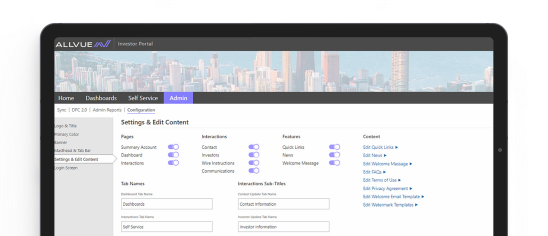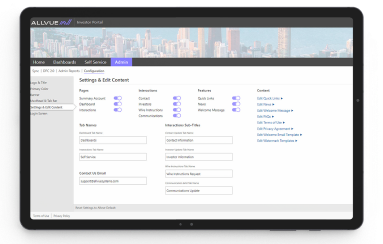
By: Michelle Wu
Head of Marketing
October 27, 2025
Over the past decade, investor transparency has become a central focus for private equity firms. This marks a notable shift from earlier practices, when attention was largely centered on deal origination and value creation, with limited emphasis on detailed reporting or investor-facing communication.
Today, however, transparency is taking center stage. Private equity firms are now expected to provide investors with timely, consistent, and comprehensive insights into fund performance, strategy, and operations.
In this guide, we’ll explore the forces driving the increased focus on investor transparency, examine the practical challenges firms face, and highlight best practices for delivering clear, consistent, and proactive communication.
Additionally, we’ll tell you how modern technology solutions like Allvue can support these efforts and help firms stay ahead in this new environment.
The Rise of Investor Transparency: Why It Matters Now More Than Ever
In the past, investor reporting was limited, sporadic, and primarily centered on aggregate fund-level performance.
Limited Partners (LPs) rarely received consistent and proactive updates on individual portfolio companies’ performance, fee and expense breakdowns, or even the firm’s approach to environmental, social, and governance (ESG) criteria.
If this information was available, it was often buried deep in lengthy legal disclosures or shared only upon specific request. Ultimately, this often made it difficult for investors to gain a full picture of their holdings.
Today, the landscape has changed dramatically.
Investor transparency has become a key priority, and firms are increasingly providing more granular, accessible, and timely updates. They are investing heavily in purpose-built technologies, enhanced data infrastructure, and strategic communication frameworks to deliver greater visibility into fund performance and operational metrics.
What Factors are Driving the Rise in Investor Transparency?
Several key forces are driving the increased focus and emphasis on investor transparency.
Growing Expectations from LPs (Limited Partners)
Today’s LPs are more sophisticated and discerning than ever before. They are allocating larger sums to alternative investments like private equity and, in turn, they expect a higher degree of insight into how their capital is being deployed and performing.
This includes a demand for more granular data, delivered with greater frequency than the traditional quarterly reports. LPs want to understand the underlying drivers of performance, assess risk exposures in real-time, and gain a deeper understanding of the operational aspects of the portfolio companies. A survey by Intertrust Group found that 80% of investors expect higher levels of transparency from fund managers, particularly when it comes to the performance of individual assets within a fund.
Moreover, LPs are placing greater emphasis on ESG factors, further expanding the scope of transparency. Investors increasingly want to align their investments with their values and understand the non-financial risks associated with their capital. As a result, GPs are under pressure to deliver clear, measurable ESG disclosures that demonstrate a commitment to responsible investing.
Increased Regulatory Scrutiny
The push for greater investor transparency is not just driven by LPs but also by heightened regulatory expectations.
Globally, regulatory bodies are enforcing stricter disclosure standards, particularly around asset valuations, risk exposures, and fund performance. This has created an environment where firms need to improve their reporting practices and enhance transparency not just to satisfy investors but to also remain legally compliant.
Competitive Market Dynamics
Beyond LPs’ demands and regulatory changes, broader market dynamics are also amplifying the transparency imperative.
As the private‑equity fundraising landscape becomes more competitive, research shows that firms that prioritize clear, consistent reporting are better positioned to secure more capital (and in less time) from both existing and new investors.
For example, a 2024 study published in the Journal of Accounting Research found that doubling the ratio of ESG-related disclosures on a PE firm’s website compared to total disclosures results in a PE firm raising approximately USD 107 million more for every six months of fundraising, or about 20% faster fundraising success.
Technology Advancement
Technology has become a major enabler of investor transparency in private equity, significantly lowering the barriers to delivering consistent, data-rich communication. What was once a costly and labor-intensive process is now faster, more accurate, and far more scalable.
For instance, private equity firms now have access to sophisticated AI-powered data platforms that can automatically pull data directly from portfolio companies, standardize it, and publish it in real time.
At the same time, cloud-based investor portals have transformed the way LPs access information. Investors can now log in at any time to view up-to-date performance metrics, fee and expense breakdowns, ESG disclosures, and risk indicators without waiting for quarterly updates or submitting specific information requests.
Benefits of Investor Transparency
Let’s look at some of the benefits that PE firms get by being more transparent with their investors.
- Builds trust and strengthens investors relationships: When firms provide clear, consistent, and timely information, it demonstrates professionalism and accountability. This builds long-term trust with LPs, fostering stronger, more collaborative relationships.
- Improves investor retention and satisfaction: Transparent communication helps LPs feel informed and confident in the management of their capital. Satisfied investors are more likely to commit to future funds, reducing fundraising friction and creating a more predictable capital-raising cycle.
- Aligns firm and investor interests: Transparent reporting offers LPs a clearer view of the firm’s performance, strategies, fees, governance practices, and potential risks, making it easier to align expectations on both sides. This minimizes the chances of misaligned goals or misunderstandings that can jeopardize the success of the investment.
- Encourages accountability across the firm: Knowing that performance, costs, and other fund metrics are shared with LPs can foster a culture of accountability in the firm. Deal teams, operations staff, and leadership are all more likely to stay aligned and focused on achieving the firm’s goals.
- Helps meet regulatory compliance: Transparent reporting ensures firms are better prepared to meet evolving regulatory requirements and mitigate the risk of compliance breaches.
Key Challenges in Achieving Investor Transparency
While the benefits of investor transparency are clear, achieving it in practice can be a complex undertaking for private equity firms. Several hurdles can impede the seamless flow of information to LPs.
Data Fragmentation
Private equity firms often manage data from multiple portfolio companies, each with its own systems, formats, and reporting standards. Consolidating this information into a unified, investor-ready view can be complex and time-consuming.
Legacy Infrastructure
Many firms still rely on legacy systems, spreadsheets, or manual workflows that are ill-suited for today’s transparency expectations. These tools are slow, error-prone, and lack the flexibility to deliver customized, real-time insights. Without modern infrastructure, it’s difficult to scale reporting practices or provide the depth and frequency of information LPs now expect.
Limited Internal Resources
Improving transparency often requires new hires, training, and investment in reporting tools. Smaller firms, in particular, may find it difficult to dedicate sufficient resources to these efforts, especially while managing day-to-day operations and portfolio oversight.
Regulatory Complexity
Private equity firms operate across multiple jurisdictions, each with its own disclosure rules and compliance requirements. Navigating this patchwork of global regulations adds significant complexity to reporting efforts and increases operational risk.
Evolving Expectations
Investor expectations for transparency are not static. They evolve continuously, driven by changes in technology, market conditions, and investor preferences. Keeping up with these shifting expectations requires constant investment in systems, processes, and personnel, which can be a resource-intensive task.
Balancing Transparency and Confidentiality
While LPs want deeper visibility, firms must also protect proprietary data, competitive strategies, and sensitive portfolio information. Striking the right balance between transparency and confidentiality can be a difficult and challenging task for private equity managers.
Best Practices for Meeting LP Demands Through Better Reporting
To meet the rising expectations around investor transparency, private equity firms must evolve their reporting practices.
Implement Centralized Data Management Systems
Firms should adopt integrated platforms that consolidate data across funds, portfolio companies, and departments. This reduces silos, improves data accuracy, and allows for more efficient and consistent reporting.
Standardize Reporting Frameworks
Using industry-recognized reporting standards, such as ILPA templates ensures consistency, comparability, and clarity in investor communication. Standardization also helps streamline internal processes and reduce confusion among LPs.
Use Technology for Streamlined Reporting
Leveraging the right technology platforms can simplify the process of gathering, organizing, and reporting data to LPs. Fund management software, for example, can automate many aspects of reporting, including the generation of standardized reports, data visualizations, and the tracking of key metrics. This not only saves time but also ensures that reports are accurate and up-to-date.
Offer Real-Time Access Through Investor Portals
Provide LPs with secure online dashboards where they can access portfolio data, performance summaries, and documents on demand. This empowers their investors to monitor their investments on their own schedule, reducing the need for frequent inquiries and promoting a sense of control and involvement. Overall, such accessibility builds trust and strengthens relationships with investors..
Seek LP Feedback and Use it to Drive Continuous Improvement
Investor reporting should be an interactive process. Encourage LPs to provide feedback on the reports and the information provided. Are they receiving the data they need? Is there anything they feel is missing or unclear? Use this feedback to continuously improve and refine your reporting practices, ensuring you’re meeting evolving expectations.
Maintain Open and Proactive Communication
Don’t wait for LPs to ask questions. Be proactive and communicate key developments early and often. Share insights into performance drivers, explain any setbacks, and be transparent about risks. Consistent, proactive communication aligns expectations and helps build investor confidence over the long term.
Provide Contextual Insights Alongside Raw Data
LPs are looking for more than just a list of figures. They want context and analysis. So instead of merely presenting raw data, take the time to explain the implications of the data and provide forward-looking insights. For example, if an investment is underperforming, don’t just highlight the loss; explain why it happened, what actions are being taken to address it, and the expected outcomes.
Offering forward-looking insights shows LPs that you’re actively managing their investments and responding to challenges.
Invest in Staff Training and Resources
To meet the demands for greater investor transparency, it’s essential to equip your team with the right skills and knowledge. Continuous training on evolving regulations, reporting standards, and technological advancements ensures that your staff is always prepared to handle reporting tasks efficiently and contributes positively to the firm’s overall transparency efforts
How Allvue Can Help You Meet LP Transparency Demands
Having the right technology partner is crucial for achieving and maintaining robust investor transparency.
Allvue Systems provides private equity firms with a suite of integrated solutions and features designed to enhance transparency, streamline reporting, and improve communication with limited partners (LPs).
Allvue’s Investor Portal: Empowering Investors with Real-Time Insights
Allvue’s investor portals offer a centralized, secure platform where LPs can access vital investment information at their convenience. Key features include:
- Intuitive dashboards: LPs can view dynamic dashboards that provide real-time insights into portfolio performance, investment activity, and capital account balances.
- Customizable reports: The portal allows for self-service reporting, enabling LPs to generate reports tailored to their specific interests and requirements.
- Secure document storage: Allvue’s portals are equipped with advanced data security features, ensuring that sensitive information remains protected while still being accessible when needed.
- Automated communications: Allvue’s system automates key communication processes, from distributing investor notices to providing regular performance updates, reducing the administrative burden and minimizing the chance for errors.
- Branding Capabilities: Firms can customize the portal to reflect their branding, providing a consistent and professional experience for investors.
Integrated Investor & Investment Management Solutions
Beyond the investor portal, Allvue offers a fully integrated suite of investor and investment management tools that work together to streamline data aggregation, reporting, and analytics.
- Data consolidation and centralized data management: Allvue allows firms to aggregate data from multiple funds and portfolio companies into a unified view, providing a single source of truth that enhances data accuracy and consistency.
- Advanced Analytics: Allvue offers powerful AI-powered analytics tools that allow firms to track and analyze key performance indicators, forecast trends, and dive deeper into portfolio dynamics. This not only enables them to offer richer, contextual information to LPs but also supports better and smarter decision making.
Wrapping Up
Investor transparency has become a fundamental aspect of successful private equity strategy in the modern day. The shift toward greater transparency is driven by multiple forces as we’ve seen including rising LP expectations, increased regulatory scrutiny, competitive market dynamics and technological advancements.
In this new environment, firms that prioritize transparency will be well-positioned to thrive and maintain strong, enduring relationships with their investors.
Allvue’s comprehensive suite of tools, including our state-of-the-art investor portal, empowers firms to do just that. With Allvue, private equity firms can streamline reporting, simplify communication, and ensure that both regulatory and investor transparency requirements are met with ease.
Request a free demo of Allvue today and discover how we can help you meet the growing demands for transparency and take your investor relations to new heights.
Sources
Intertrust Group. A ‘new world’ for private equity after a global pandemic. https://cscwebcontentstorage.blob.core.windows.net/cscmarketing-cscblog-media/uploads/2024/02/Intertrust_PE_Report_US-FINAL.pdf
Krueger, P., Landier, A., & Sraer, D.. ESG disclosure and private equity fundraising. Journal of Accounting Research. https://doi.org/10.1111/1475-679X.12570
ILPA. ILPA Reporting Templates. https://ilpa.org/industry-guidance/templates-standards-model-documents/reporting-template/
More About The Author

Michelle Wu
Head of Marketing
Michelle is a dynamic marketing leader with 15+ years of experience in capital markets, fintech, and cybersecurity technology industries. Prior to joining Allvue, Michelle was the Vice President of Product Marketing at SecurityScorecard, a global leader in cybersecurity ratings, and was the Head of Security & Compliance Marketing at Box. Before moving into cybersecurity, she led the Banking & Securities GTM strategy at Intralinks and covered capital markets clients at HSBC. She holds an MSc in Media & Communications from the London School of Economics and a BS in Marketing & Finance from NYU Stern School of Business.


